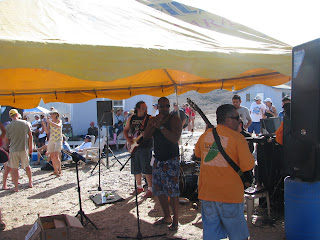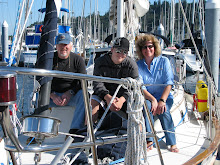Time went quickly while we were in Cabo, but we never felt really relaxed here. Too much noise, congestion, and activity.
 |
| Baja Ha Ha Party at El Squid Row |
After 7 days we finally left Cabo San Lucas. We were obliged to stay longer than we wanted to complete repairs and wait for delivery of detailed Garmin Mexico chart data from West Marine International. Not all went according to plan. The autopilot was still broken when we left Cabo San Lucas and we had to cancel our order for Mexican chart data because West Marine couldn't ship it in time. But we refused to stay any longer in Cabo!
When we first arrived at Cabo San Lucas we stayed two nights in a marina that was next to a small Mexican Navy base. We rented a large slip for $240 dollars a night, then had to find one or two other boats to share the slip and cost. Luckily, we were able to find other boats to share the cost both nights. On the second night, Larry and Nelda on s/v Diamond Girl took us up on our offer to share our slip, and they were kind enough to give us 40 gallons of drinking water that they made using their reverse osmosis water maker.
One of the best deals we found in Cabo was laundry. We dropped off a large garbage bag full of dirty laundry at the marina office and the next morning picked up our laundry; cleaned, dried and folded for only $20. Water taxis were also readily available and cheap. We were able to go to town and the beaches by hailing a water taxis from the fuel dock for only $2 each. On our second day in Cabo we attended the last Baja Ha Ha party on the beach at Cabo. It was fun talking to the other Baja Ha Ha sailors while drinking many cool Pacifico cervezas and eating pork tacos, beans and rice.
Cabo was fun while the Baja Ha fleet was docked in the marina with us but it got old really fast after they left. Music from the night clubs surrounding the marina blasted us from 11PM until 4AM, then at 5AM the guys working on the sport fishing boats started working, and of course they couldn't work without loud music and constant yelling half way across the marina. That gave us about 1 hour of peace and quiet every night. You could imagine how quickly we tired of that! After the boats returned from a successful fishing trip, they'd clean the fish and throw away the carcasses into the water next to their boat. If we were lucky the sea lions and pelicans would eat the carcasses right away; if not a carcass would remain floating too long and it would begin to rot in the sun and warm water, making a very unpleasant odor. Luckily, the sea lions and pelicans didn’t miss too many scraps.
We enjoyed watching the sea lions play with their food and dog the fisherman for scraps. When a sea lion had a large carcass in his mouth he would swim in to the middle of the fairway and swing the carcass over his head out of the water. Sometimes he would throw it across the water, only to attack it again. Pelicans were ever present during this sea lion eating frenzy, ready to grab any scraps that were torn from the carcass as it flew through the air. Pelicans didn’t always wait for scraps of food though; often they would climb onto the stern of the fishing boat and beg for fish. On one boat we saw several pelicans steal bait fish from the live well while the fisherman was looking the other way. When I tried to photograph this covert activity, they stopped what they were doing and acted like innocent creatures.
 |
| Pelicans moving in on a fishing boat that just returned from sea. |
 |
| Pelicans sitting above live bait well, waiting for a chance to grab a mackrel. |
In the inner harbor of Cabo San Lucas, vendors of all sorts line the plazas surrounding the docks, pestering tourists constantly: selling Cuban cigars, silver, massages, whistles, dolls, hats, ponchos, pottery and other trinkets. Alex said that the silver vendors also tried to sell him drugs. In fact, there was a shootout in Cabo a week before we arrived after the Navy arrested a drug dealer and in retaliation the drug dealers assassinated the Chief of Police. Then the Navy sent the Marines to capture the heavily armed drug dealers and a shootout ensued. One soldier and one drug dealer were killed. The news reported that Cabo was locked down for a while after the gunfire. I am happy to say that we were not there at the time, we only read about it.
Daytime temperatures of 95 degrees were typical for early November and many nights were hot with little wind. Nether Cindy or I wanted to cook, so we ate out every night. While the restaurants weren't extravagantly expensive we paid at least $65 for dinner for the three of us: Margaritas and cervezas included. Alex liked the restaurants in Cabo because they served him cerveza without asking for proof of age. In fact all of Mexico is like that. He's not going to like the return of "blue laws" when we return to Seattle. We had enchiladas, tacos, fajitas, and a kind of Mexican stew that was very good. We also tried a cactus salad and found it to be “muy bueno”.
Cabo is a good place to provision cruising boats with food, beverages and other essentials. We refilled our larder for the next half of our voyage. We found Costco, Wal-Mart, and Home Depot nearby to the marina and taxis were easy to find for the trip to and from the stores. Unfortunately, marine supplies are very limited and what they have is almost exclusively for sport fishing boats and not for sailboats.
While in Cabo I continued to work on our autopilot. Cindy and Alex decided to skip this activity; instead they took a water taxi to the arches to go snorkeling. I remained aboard and managed to get the hydraulic part of the autopilot working by adding 3 cups of hydraulic fluid to the unit and bleeding the air out of the system. It appeared to work fine when I tested it out of the boat, but the motor and solenoid heated up more than I thought normal when I connected it to 12 volts of current. After I installed the unit back in the boat and switching it on, the autopilot reported a different error on the display: "trip". The auto pilot computer detected higher amperage draw then was normal. By isolating the motor and solenoid, I discovered that the motor was the culprit. Now I'd have to wait until we get to La Paz before I could find a shop to rebuild the motor. By this time I was dripping in sweat, filthy and very disappointed.
 |
| Craig adding hydraulic fluid to autopilot. |
 |
| At this point I thought I fixed it...later I learned differently. |
Cindy and Alex returned to the boat about this time, refreshed from their snorkeling adventure. While I dripped sweat they told me about the clear and warm water, and the many colorful fish they saw while snorkeling. Cindy told me about an underwater statue that she saw and Alex added, “mom thought it was a scuba diver at first”…”she didn’t notice that there were no bubbles coming from his mouth”. I was envious and ready to dive into a cold beer at that point.
While my attention was focused on the autopilot, the AC Battery Charger decided to stop working. Luckily, we had a good alternator and solar panels so we really didn't need to charge the boat at the docks. I called the manufacturer to ask how to troubleshoot the charger, and they gave me some useful ideas: check wiring to batteries and check the 30 amp breaker on the charger. If the breaker wasn't working I could by-pass it or replace it with an external breaker. That fun activity will have to wait until we get to La Paz. Someone once told me that the definition of cursing was "working on your boat in exotic locations". I'm finding that to be very true.
Before leaving our family voted 2:1 to go to a hotel for a one night break from the boat (mine was the only dissenting vote). So with reservations in hand, we hailed a land taxi and headed for the Sheraton Hotel east of town. That afternoon we sat by the pool, swam, soaked in the hot tub and drank cervezas and ate nachos. Later, we showered and enjoyed dinner in our air conditioned room while watching a movie. In the morning we each took another shower (that was the biggest luxury!) and ate a leisurely breakfast while studying the navigation charts and the route to the next anchorage at Bahia Frailes.
When we returned from the hotel, we took another taxi to Wal-Mart for last minute provisions and filled the boat with 40 more gallons of water. The following morning we fueled up and took off for Bahia Frailes. Fueling the boat took longer than we expected so we didn’t get away from the dock early enough to make our destination, so we stopped 15 nm up the coast at Puerto Los Cabos marina for the night. From there it would be only 30 nm trip to Bahia Frailes
 |
| Last night at Cabo San Lucas |








































